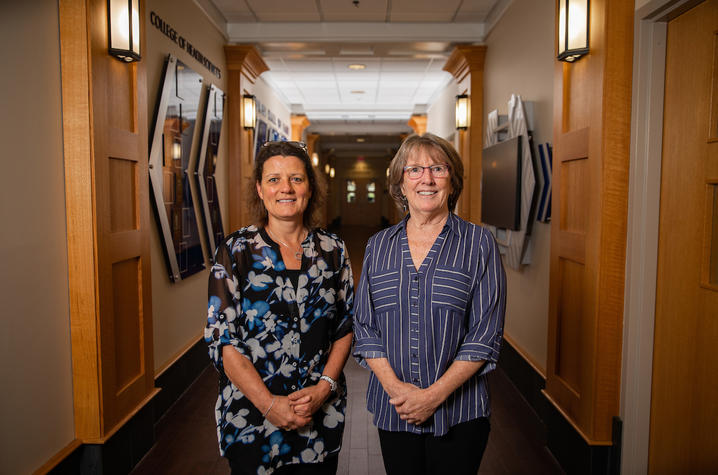‘Truly Remarkable’: Center for Muscle Biology Lives Up to Challenge During COVID-19

One of the main sources of physical power in the body derives from muscle. Research studies in skeletal muscle show the influences of aging, chronic diseases, and physical activity on overall function and health.
And that muscle research, at least at the University of Kentucky, is now housed within the UK College of Health Sciences.
In January, the Center for Muscle Biology (CMB) officially transferred from the UK College of Medicine to become a part of the UK College of Health Sciences, where it occupies more than 5,000 square feet of research laboratory space in the C.T. Wethington Building, along with shared space for human research in the Multidisciplinary Science Building. The Wethington wet labs also house two core facilities: the Muscle Immunochemistry and Molecular Imaging Core (MIMIC) and the Muscle Function Core.
Formally established in June 2008 to support and integrate basic, clinical and translational research on muscle throughout the University of Kentucky, CMB fosters collaboration among clinical and basic scientists, catalyzes translational research, stimulates educational activities, and increases national recognition for the university in the field of muscle-based research.
From communication sciences and disorders to athletic training and rehabilitation sciences, CMB Director and professor Charlotte Peterson, Ph.D., says that the continuous expansion of muscle research is groundbreaking.
“What we’re learning about muscle is relevant on many health-related fronts and should be taken into account when studying chronic disease, and in designing rehabilitation strategies,” Peterson said. “Evidence is the key and the only way we’re going to continue gathering evidence is through research.”
And it is research that is essential, as it is widely recognized that injury, aging and chronic diseases including stroke, heart disease, liver disease, arthritis and cancer, are associated with loss of muscle mass and strength, Peterson said. Frailty is often an early and strong predictor of increased mortality, and a major contributor to disability.
Currently, there are 25 investigators collaborating with CMB, spanning five different colleges, and the program continues to expand each year.
Under Peterson’s leadership, the center now holds a grant portfolio of just over $22 million from organizations including:
● National Institute on Aging (NIA)
● National Institute of Arthritis and Musculoskeletal and Skin Diseases (NIAMS)
● National Institute of Diabetes and Digestive and Kidney Diseases (NIDDK)
● National Center for Complementary and Integrative Health
● Department of Defense
MUSCLE POWERS HEALTH
The motto of the CMB is "Muscle Powers Health."
It seems to go hand-in-hand with the mission of the center, which is to serve as a hub of interdisciplinary collaboration by engaging students, early-stage and senior investigators of various scientific backgrounds in research to understand mechanisms regulating muscle structure and function. This fostered collaboration enables development of novel approaches to maintain and improve physical function.
But one of the more remarkable aspects of the center has been the investigators’ ability to continue to research and publish during a time when similar labs across the country were forced to close due to COVID-19 response restrictions.
Peterson and others realized that if they had to close, one group who would lose out would be their trainees. So, they developed a plan — utilizing social distancing and other protective measures — to remain open, albeit with far fewer people working at a time. Once approved, they continued their business, but also spent more time analyzing existing data, meeting by Zoom, writing and publishing manuscripts, and completing dissertations.
The results have been extraordinary.
Since March 2020, the labs and researchers from the CMB have produced an impressive amount of published material and grants, with more than 60 publications, and more than $8 million in newly funded research. And that does not count the millions of dollars in proposals that are still pending.
“The lights didn’t go out in CMB,” said Esther Dupont-Versteegden, Ph.D., associate director of the center. “You can’t do experiments at home. But we were able to come up with a safe plan to keep working. And it’s something I think a lot of us will take with us — I find that I make time to go home now, and accomplish things there, too.”
OFFICIALLY HOME
It has all added up to a valuable addition to the college, even if it did occur during one of the most challenging times of the university’s history.
“We look at the production of vital research and the quality of the academics that come from those in the Center of Muscle Biology, and we are just thrilled to have them as an official part of our college,” said CHS Dean Scott Lephart, Ph.D. “We also need to commend them for their response to COVID-19. Their performance should be a template for others across campus and the nation. It’s been truly remarkable.”
For those in CMB, it feels like they are officially home.
“We’ve built a community here,” Peterson said. “And we are producing, whether that is bringing in grant funding, or contributing to our national and international reputation as an authority on cutting edge muscle research. We’re excited to see what we can continue to do in the future.”
To learn more about CMB visit www.uky.edu/chs/center-for-muscle-biology.
Credits
Ryan Clark (College of Health Sciences)
